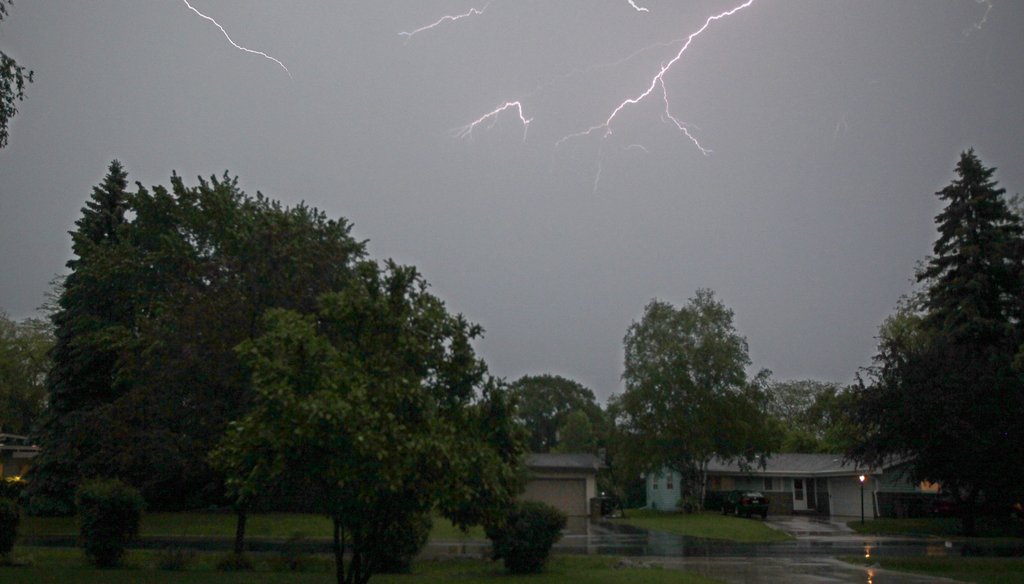Stand up for the facts!
Our only agenda is to publish the truth so you can be an informed participant in democracy.
We need your help.
I would like to contribute

Lightning strikes Round Rock in 2003.
Would you rather be shot by someone with a concealed handgun license or struck by lightning? Whatever your preference, the latter is more likely to happen, says state Rep. Van Taylor, R-Collins, who has filed legislation to allow concealed handgun licensees to bring their guns to public junior college campuses.
"You’re more likely to get struck by lightning than to get shot by a CHL owner," he was quoted as saying in a March 16 Texas Monthly blog post.
A simple statement, but not so easy to check. In fact, it knocked the Truth-O-Meter for a loop.
Responding to our request for backup for Taylor’s statement, Brittany Eck, his chief of staff, first pointed us to statistics kept by the National Weather Service at the National Oceanic and Atmospheric Administration.
According to the agency’s website, the United States has annually averaged 58 reported lightning fatalities over the past 30 years. Due to under-reporting, the site says, the figures are more realistically at least 70 deaths a year. The agency estimates that the odds of someone in the U.S. being struck by lightning in a given year are one in 500,000.
Last year, 29 people were killed by lightning in the U.S., including two men who died in Texas. In 2009, Florida had the most fatalities of the 34 who were killed by lightning — five — followed by Texas and North Carolina, which each saw three fatalities. Looking at the state’s population in 2009 — about 25 million according to the U.S. Census Bureau — that’s one in 4,956,460.
What about folks who were hit by lightning but survived? Paul Yura, a San Antonio-based meteorologist with the National Weather Service, told us those incidents are "too hard to track. If we hear about lightning injuries, we’ll typically log them down, but many go unreported."
However, Yura showed us federal data on some injuries. From 1993 through 2010, Texas had 246 injuries and 57 deaths — 303 total reported lightning strikes, an average of about 18 per year. In 2009, 11 folks were injured in Texas. Add in the three who were killed and that’s at least 13 people struck by lightning that year, not counting strikes that went unreported.
Next, we sought data on shooting incidents.
Eck cited 2009 data — the most recent available — on criminal conviction rates for concealed handgun license holders kept by the Texas Department of Public Safety. As of Dec. 31, Texas has 461,724 active license holders. The information is on the agency’s website.
However, when we asked how many CHL holders in Texas had been arrested — not necessarily convicted — for incidents that could have involved a shooting, DPS spokeswoman Tela Mange told us that the agency doesn’t have that information.
What’s more, in cases of aggravated assault or assault with a deadly weapon, the data don’t detail what kind of weapon was used. So, for instance, a CHL holder who committed aggravated assault could have been wielding a handgun — or a tire iron.
Eck told us that since she couldn’t determine which crimes were committed with a firearm, she included all crimes involving weapons, unless the report specifically noted that the incident didn’t result in injury or death, or the weapon was listed as something other than a firearm — brass knuckles, for example.
She also said that Taylor’s statement referenced a point made previously by W. Scott Lewis, Texas legislative director of Students for Concealed Carry on Campus, who has stated that "a person is 20 times more likely to be struck by lightning than to be killed by a concealed handgun holder." Taylor meant to say ‘shot and killed,’ Eck told us, though she said both his and Lewis’s statements "are true."
In all, we found that 23 of the 101 convictions for CHL holders in 2009 involved a weapon that could have been a firearm. Gauging that against Texas’ population in 2009 — about 25 million — that’s one in 1,077,491.
Paul Helmke, president of the Washington-based Brady Campaign to Prevent Gun Violence, speculated that the statistic is too low, but cannot prove it because the information the Brady Campaign has collected on shootings by CHL holders came from news accounts rather than government data.
Helmke pointed us to the Violence Policy Center, a Washington-based gun control group which tracks media reports on people killed by CHL holders. Since 2007, four Texas CHL holders have been involved in reported shooting incidents, according to the center. In May 2009, CHL holder Ronnie Cook exchanged gunfire with police after he shot and killed his wife. Both Cook and his wife were handgun instructors. Last year, Cook pleaded guilty to one count of murder and four counts of attempted murder of the officers.
How many people may have been shot by CHL holders who were never arrested on a criminal charge? How many CHL holders may have been arrested in connection with shootings but not convicted? DPS Spokesman Tom Vinger told us the agency doesn’t track shootings.
Kristen Rand, legislative director with the Violence Policy Institute, told us that the number of shootings by CHL holders anywhere is "unknowable" because "no entity, state or federal, tracks shootings by people licensed to carry."
Plus, according to a June 2002 report issued by the center, "public information about the arrests of Texas concealed handgun license holders became more limited than ever" on Sept. 1, 2001, when a new law took effect. The original concealed handgun law required DPS to keep tabs on arrests of CHL holders for offenses under the law or for discharging a handgun; the 2001 revisions restricted those statistics to convictions for "certain serious offenses" — robbery, burglary, an offense against a person or an offense involving the unlawful use or possession of a weapon, according to the bill analysisby the Office of House Bill Analysis.
Before 2001, the center obtained arrest data from the DPS. It found that from 1996 to 2000, 38,830 people 21 and older were arrested for weapons-related offenses, including 279 assaults or aggravated assaults with a deadly weapon, 671 unlawful carrying of a weapon, and 172 arrests for deadly conduct or firearm discharge.
Among those, Texas CHL holders were arrested for 5,314 crimes, according to the report. "The weapons-related arrest rate among Texas concealed handgun license holders from 1996 to 2000 was 417.2 per 100,000." The center said that arrest rate was 66 percent higher than the state’s population aged 21 and older. Again, those weapons aren’t necessarily firearms, let alone concealed handguns.
Where does that leave us?
Largely without the data that’s needed to prove up Taylor’s attention-getting claim. While NOAA has calculated the likelihood of being struck by lightning in a given year, we lack sufficient information to gauge the chances of being shot by a CHL holder — and so does Taylor. He only cites conviction rates for CHL holders, and the available DPS data doesn’t specify whether the crime involved firing a gun.
Without that information, Taylor’s claim cannot be proved or disproved. So the Truth-O-Meter stands still.
Our Sources
Texas Monthly, BurkaBlog post: campus carry bills will be heard today, March 15, 2011
HB 1167 relating to the carrying of concealed handguns on certain premises of or locations associated with schools or public junior colleges and public technical institutes, filed Feb. 7, 2011
Texas Department of Public Safety, Conviction rates for concealed handgun license holders, Jan. 1, 2009 - Dec. 31, 2009
National Ocean and Atmospheric Administration, National Weather Service, Medical aspects of lightning, accessed March 21, 2011
Violence Policy Center, Concealed carry killers, accessed March 28, 2011
Violence Policy Center, License to Kill IV: More guns, more crime, June 2002
House Bill 2784 relating to recordkeeping pertaining to incidents involving persons licensed to carry a handgun, effective Sept. 1, 2001
Senate Bill 60 relating to the issuance of a license to carry a concealed handgun; requiring of an applicant for the license a handgun proficiency and safety training course and a criminal background check; providing penalties, effective Sept. 1, 1995
CampusCarry.com, Asking "where were the armed heroes?" reveals ignorance of history, Jan. 13, 2011
Interview with Brittany Eck, chief of staff for state Rep. Van Taylor, March 21, 2011
E-mail interview with Tom Vinger, public information officer, Texas Department of Public Safety, March 21, 2011
Interview with Paul Yura, warning coordination meteorologist, National Weather Service, March 22, 2011
Interview with Paul Helmke, president, Brady Campaign to Prevent Gun Violence,
Interview with Gail Hayes, senior press officer, National Center for Injury Prevention and Control, Centers for Disease Control and Prevention, March 22, 2011
Interview with Tela Mange, chief of media relations, Texas Department of Public Safety, March 29, 2011
E-mail interview with Alice Tripp, legislative director, Texas State Rifle Association, March 29, 2011
Interview with Kristen Rand, legislative director, Violence Policy Center, March 29, 2011
























